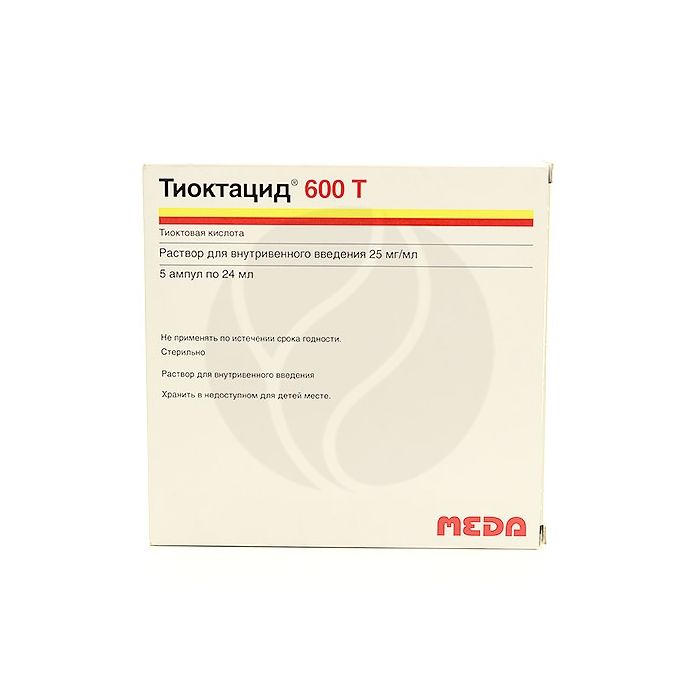Thioctacid T solution for injection 600mg / 24ml, No. 5
Russian Pharmacy name:
Тиоктацид Т раствор для инъекций 600мг/24мл, №5
Diabetic and alcoholic polyneuropathy
The drug is administered intravenously. The recommended dose for severe polyneuropathy is 1 ampoule (600 mg) once a day for 2-4 weeks.
In the future, the patient is transferred to treatment with ThioctacidЃ BV at a dose of 600 mg (1 tablet) per day.
Intravenous administration of the drug should be carried out slowly (no faster than 2 ml / min).
Intravenous administration of an undiluted solution is also possible using an injection syringe and perfuser. In this case, the administration time should be at least 12 minutes.
Due to the sensitivity of the active substance to light, ampoules should be removed from the carton immediately before use.
Recommendations for infusion
The drug ThioctacidЃ 600 T can be used as an infusion in 0.9% sodium chloride solution (infusion volume - 100-250 ml) for 30 minutes.
The infusion solution should be protected from light (for example, by wrapping the container with aluminum foil).
Solution for intravenous administration, protected from light, is usable within 6 hours.
1 ampoule of solution contains:
Active ingredient: thioctate trometamol - 952.2876, in terms of thioctic (a-lipoic) acid - 600 mg.
Excipients: trometamol, water for injection
Hypersensitivity to thioctic acid or other components of the drug.
Pregnancy, breastfeeding period (there is no sufficient experience with the drug).
There are no clinical data on the use of ThioctacidЃ 600 T in children and adolescents; therefore, the drug should not be prescribed to children and adolescents.
Detailed description:
Pharmacodynamics
Thioctic (a-lipoic) acid is found in the human body, where it acts as a coenzyme in the reactions of oxidative phosphorylation of pyruvic acid and alpha-keto acids. Thioctic acid is an endogenous antioxidant; in terms of its biochemical mechanism of action, it is close to the B vitamins.
Thioctic acid helps to protect cells from the toxic effects of free radicals arising in metabolic processes; it also neutralizes exogenous toxic compounds that have entered the body. Thioctic acid increases the concentration of the endogenous antioxidant glutathione, which leads to a decrease in the severity of symptoms of polyneuropathy. The drug has a hepatoprotective, hypolipidemic, hypocholesterolemic, hypoglycemic effect; improves the trophism of neurons. The result of the synergistic action of thioctic acid and insulin is an increase in glucose utilization.
Pharmacokinetics
The main metabolic pathways are oxidation and conjugation. The volume of distribution is about 450 ml / kg. Thioctic acid and its metabolites are excreted by the kidneys (80-90%). The half-life is 20-50 minutes. The total plasma clearance is 10-15 ml / min.
Side effect
The incidence of side effects is determined as follows:
Very often:> 1/10;
Often: <1/10> 1/100;
Uncommon: <1/100> 1/1000;
Rarely: <1/1000> 1/10000;
Very rare: <1/10000.
Allergic reactions:
Very rarely - skin rash, urticaria, itching, eczema, skin redness, systemic allergic reactions up to anaphylactic shock.
From the nervous system and sensory organs: Very rarely - convulsions, diplopia.
On the part of the blood and cardiovascular system:
Very rarely - purpura, punctate hemorrhages and a tendency to bleeding (due to dysfunction of platelets), thrombocytopathy, thrombophlebitis.
General:
Often - with rapid intravenous administration, there may be an increase in intracranial pressure and difficulty in breathing, which pass on their own.
Infrequently - violation of taste (metallic taste).
Rarely, allergic reactions may occur at the infusion site.
Rarely - nausea and vomiting.
Very rarely - due to improved glucose utilization, blood glucose levels may decrease and symptoms of hypoglycemia (confusion, increased sweating, headache, visual disturbances) appear.
Overdose
There were no cases of overdose with thioctic acid in the form of a solution for intravenous administration.
In case of overdose, symptomatic treatment, if necessary, anticonvulsant therapy, measures to maintain the functions of vital organs.
Interaction with other drugs
With the simultaneous appointment of thioctic acid and cisplatin, a decrease in the effectiveness of cisplatin is noted. With the simultaneous use of thioctic acid and insulin or oral hypoglycemic drugs, their effect may be enhanced, therefore, regular monitoring of blood glucose levels is recommended, especially at the beginning of thioctic acid therapy. In some cases, it is permissible to reduce the dose of hypoglycemic drugs in order to avoid the development of symptoms of hypoglycemia.
Ethanol and its metabolites weaken the effect of thioctic acid.
special instructions
Thioctic acid infusion solution is incompatible with dextrose solution, Ringer's solution and with solutions that react with disulfide and SH-groups, ethanol. Alcohol use is a risk factor polyneuropathy, and may reduce the effectiveness of the drug Thioctacid Ѓ 600T, so patients should abstain from alcoholic beverages like during drug treatment, and in the treatment periods is.
Treatment of diabetic polyneuropathy should be carried out while maintaining the optimal concentration of glucose in the blood.

